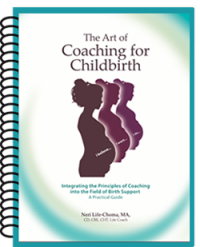
Five Best Coaching Strategies for Childbirth’s Moments of Crisis
Do you know how to empower your birth client through moments of crisis?
The process of childbirth presents birthing women with some recognized moments of emotional crisis, as well as some unexpected ones, related to the unfolding of the birth. My experience has been that the known and expected emotional crises occur during transitions or changes occurring throughout the process. It is common knowledge that the transition from one phase of birth to another triggers an emotional reaction. For example, the transition from the early phase of labor to active labor is symptomized by the emotional change in which excitement and self-confidence give way to fear, despair, or self-doubt. Birthing mothers express these new emotions in a variety of ways: If they are talkative, they might express them by sharing their thoughts, such as: “Do you think it’s time to head the hospital”? Or “Do you think all these contractions are doing anything”?, “Do you think I’m progressing?” and “How much more painful will this be”? If they are more withdrawn and introverted, they might cry or breathe heavily. If you are a practicing doula, I’m sure you are very familiar with the repeated situation of a client bursting in tears upon your arrival at her home, despite her successful coping with the process. This is due to the fact that doulas usually join the couple when the mother transitions from the early phase of birth to active labor.
The unfolding of childbirth presents many moments of crisis, and these can stimulate an emotional reaction of self-doubt and fear
There are other transitions in labor that can stimulate an emotional reaction, such as the physical change of leaving the couple’s home toward the hospital, or even a change in caregivers during shift replacement. These moments are destined to stimulate emotional reactions, which for some can be experienced as an emotional crisis. Coming to think of it, it worth examining these transitions, or changes, as sources of stress and discomfort that lead to moments of emotional crisis, rather than focus solely on labor pain as the main cause for childbirth strains. Likewise, this suggests that the support women need in these moments is not so much physical support as much as it is emotional and verbal support or coaching.
Learn these five coaching techniques to help your client overcome the crisis
It appears that leading a birthing woman to overcome these moments of emotional crisis, skillfully and with confidence, is important artistry a childbirth support practitioner should master. Therefore, I gathered some coaching strategies that have served me and my birthing clients as we strive through these moments:
1. Echoing: Echo is the repetition of a word or phrase. Repeating the client’s words back to her exactly as she said them reassure the client that she is being heard.
Our automatic reaction when we support our loved ones, or our clients, is to search for a solution. As birth workers, we might suggest a change of position or a new massage technique, when all the mother needs to recover her doubt or other challenge is to know that we are present for her and to be reassured that she’s been heard. For example, if your client says: “How much more painful will this be”? You can echo her by saying: “I understand that you’re in pain now and you want to know how much more painful it will be”.
2. Tapping on your client’s motivation: Conducting a series of prenatal coaching sessions allows you to become familiar with your clients’ personal motivations. Some examples of those can be spiritual in nature: “It is important for me to experience childbirth the same way the long chain of women I come from experienced it’. Others can be physical: “I want to stay connected with my body, I don’t want to give-up and num all the sensations”. Your clients’ motivations should appear on your intake form and you can remind yourself of these while preparing to join her in labor. Have them available for you when she needs to give rise to strength relying on her own words and wishes.
3. Remind them that they are giving birth this way by choice: Pain and bodily discomforts are associated with the emotional reaction of stress, sometimes referred to as fight-or-flight response. Studies in the field of pain define pain as an unpleasant sensory and emotional experience associated with actual or potential tissue damage. Labor pain is not pathogenic in nature, but women react to it in the same way. Reminding birthing mothers that they are in the process of becoming mothers and giving birth to their child, and are therefore in it by choice, has proved itself to be extremely valuable in my practice. You may just say: “Do you remember how much you wanted this healthy labor that you’re having? You are giving birth to your baby just the way you wished to!”
4. Reassure that it is healthy: Similar to reminding the mother that she is going through this process by choice is the needed reminder that the process is healthy. Saying: “You are giving birth in the most healthy way possible, and everything you feel now is healthy” is a much-needed reminder for the primal brain that reacts to bodily discomforts as threats to our survival.
5. Break the process into short intervals: When a woman is emersed in the process of giving birth, it might seem to her like an awfully long process with no prediction to its endpoint. Therefore, breaking it into short intervals can help her navigate through the process and conduct herself better. You can definitely coach the mother by saying: “I get this is how you feel right now, and I think it’s the result of ______________(Here you would name the transition or change that you know just occurred), therefore I suggest that we try for another 15-20 minutes before you take any major decision.” Then look at the clock and state the exact time in which you will revisit a new pathway for her birth. It is my experience that when the time arrives you’ll be able to say “You can be really proud of yourself, look how you have triumphed these past 20 minutes and how strong you are now!”
Your clients’ motivations should appear on your intake form
Over the years and throughout my book, I have shared more coaching strategies around the topic of coping with labor pain and strains. You may also consider joining the Birth Support Coaching Certificate Course dedicated solely to verbal coaching throughout pregnancy and childbirth. The course consists of online classes followed by Zoom meetings to allow the community of birth pros. to grow together as coaches. You may click HERE to receive notifications about the upcoming course.
Positive Mindsets, Positive Births!
- Matrescence: Identity-Shifting Transformation - March 12, 2024
- Empowering Black Birthgivers! - February 12, 2024
- Let’s Get Clients in 2024! - January 23, 2024


